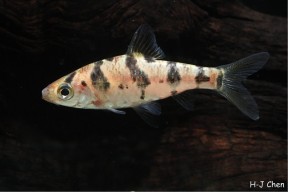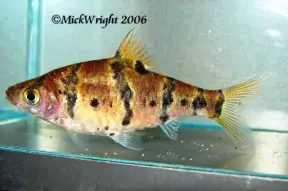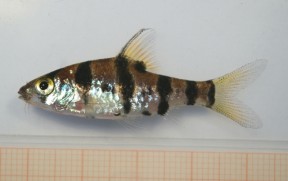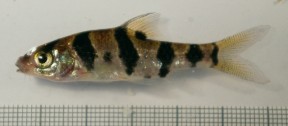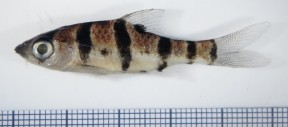Desmopuntius foerschi
SynonymsTop ↑
Barbus foerschi (Kottelat, 1982); Puntius foerschi (Kottelat, 1982); Systomus foerschi (Kottelat, 1982)
Etymology
Desmopuntius: from the Ancient Greek δεσμψτης (desmotes), meaning ‘prisoner’, and the generic name Puntius, in reference to the barred colour pattern in member species.
foerschi: named for Dr. Walter Foersch.
Classification
Order: Cypriniformes Family: Cyprinidae
Distribution
Appears to be native to the Indonesian provinces of Kalimantan Timur (East Kalimantan) and Kalimantan Tengah (Central Kalimantan) on the island of Borneo although information is quite scarce.
Type locality is ‘About 50 to 100 kilometers north of Sampit, Kalimantan, Indonesia’, which presumably refers to the Sampit (aka Mentaya) River basin while the only other details we’ve been able to obtain suggest that it’s also been collected from the Mahakam drainage.
Habitat
Probably inhabits peat swamps and associated blackwater streams as with related members of the genus.
Such habitats are typically shaded from the sun by marginal vegetation and the dense tree canopy above.
The water generally has a negligible dissolved mineral content, is poorly buffered and pH can be as low as 3.0 or 4.0 due to the gradual release of tannins and organic acids from decaying plant material.
Depending on locality the substrate may be composed of peat, mud or sand littered with submerged woody structures and leaf litter.
Maximum Standard Length
50 – 55 mm.
Aquarium SizeTop ↑
Base dimensions of at least 80 ∗ 30 cm or equivalent are required.
Maintenance
Can be kept in a planted aquarium and is an excellent choice for the carefully-aquascaped set-up.
The addition of some floating plants and driftwood roots or branches to diffuse the light entering the tank also seems to be appreciated.
To see it at its best a biotope-style set-up can also make an interesting project.
A soft, sandy substrate is probably the best choice to which can be added a few driftwood roots and branches, placed in such a way that plenty of shady spots are formed.
The addition of dried leaf litter would further emphasise the natural feel and fairly dim lighting should be used to simulate the conditions the fish would encounter in the wild.
You could also add some aquatic plants able to survive under such conditions such as Microsorum, Taxiphyllum, or Cryptocoryne spp.
Water Conditions
Temperature: 20 – 28 °C
pH: 5.0 – 7.0
Hardness: 18 – 179 ppm
Diet
Wild fish are probably foragers feeding on diatoms, algae, organic detritus, small insects, worms, crustaceans, and other zooplankton.
In the aquarium it’s easily-fed but the best condition and colours offer regular meals of small live and frozen foods such as bloodworm, Daphnia, and Artemia, alongside good quality dried flakes and granules, at least some of which should include additional plant or algal content.
Behaviour and CompatibilityTop ↑
Should prove an ideal addition to a peaceful community of Southeast Asian fishes such as similarly sized cyprinids, nemacheild or cobitid loaches, and certain anabantoids.
Avoid boisterous or very vigorous tankmates as they may outcompete it for food.
It’s a schooling species by nature, and really should be kept in a group of at least 8-10 specimens.
Maintaining it in decent numbers will not only make the fish less skittish but result in a more effective, natural-looking display, and males will also display their best colours as they compete with one other for female attention.
Sexual Dimorphism
Adult males tend to be slightly smaller, are noticeably slimmer, and exhibit more intense colouration than females of a similar age.
Reproduction
Unrecorded.
NotesTop ↑
D. foerschi is sometimes traded as ‘boomerang barb’ or ‘Foersch’s fire barb’ and is included in a group of closely-related, similar-looking fishes which were moved into the new genus Desmopuntius by Kottelat (2013).
It can be told apart from other vertically-striped congeners by possession of additional dark blotches between the second, third and fourth vertical bars and a further marking at the posterior base of the dorsal-fin.
This species was formerly included in the genus Puntius which was for a number of years viewed as a polyphyletic catch-all containing over 100 species of small to mid-sized cyprinid until Pethiyagoda et al. (2012) published a partial review covering South Asian members.
The majority of sub-Himalayan Puntius species were reclassified and new genera Dawkinsia, Dravidia (subsequently amended to Haludaria), and Pethia erected to accommodate some of them, with the remainder either retained in Puntius or moved to the existing Systomus assemblage, though the definition of the latter was altered meaning some Southeast Asian species formerly placed there could no longer be considered members.
Kottelat (2013) published a comprehensive nomenclatural update for Southeast Asian fishes in which the genus Desmopuntius was raised and diagnosed as follows: unique colour pattern made of 4–6 bars at least in juveniles, anterior bar across eye, 2nd bar behind gill opening, 3rd bar at dorsal-fin origin, 4th bar at anal-fin origin, 5th bar at middle of caudal peduncle, and 6th at caudal-fin base; often a black spot at posterior extremity of dorsal-fin base. In D. gemellus, D. johorensis and D. trifasciatus the barred pattern is present only in juveniles and with increasing size transforms into a striped pattern.
In addition, the following characters are useful in identification of Desmopuntius spp.: last simple dorsal-fin ray serrated posteriorly; rostral and maxillary barbels present; lips smooth and thin, postlabial groove interrupted medially; lateral line complete, with 25–27 pored scales on body; ½4/1/4½ scale rows between dorsal-fin origin and ventral midline in front of pelvic-fin base; 12 circumpeduncular scale rows; 7–11 gill rakers on first gill arch.
References
- Kottelat, M., 1982 - Revue Suisse de Zoologie 89(2): 419-437
A small collection of fresh-water fishes from Kalimantan, Borneo, with descriptions of one new genus and three new species of Cyprinidae. - Kottelat, M., 1992 - Raffles Bulletin of Zoology 40(2): 187-192
The identity of Barbus johorensis Duncker, 1904 (Teleostei: Cyprinidae). - Kottelat, M., 2013 - The Raffles Bulletin of Zoology Supplement 27: 1-663
The fishes of the inland waters of southeast Asia: a catalogue and core bibiography of the fishes known to occur in freshwaters, mangroves and estuaries. - Kottelat, M. and H-H Tan, 2011 - Ichthyological Exploration of Freshwaters 22(3): 209-214
Systomus xouthos, a new cyprinid fish from Borneo, and revalidation of Puntius pulcher (Teleostei: Cyprinidae). - Pethiyagoda, R., 2013 - Zootaxa 3646(2): 199
Haludaria, a replacement generic name for Dravidia (Teleostei: Cyprinidae). - Pethiyagoda, R., M. Meegaskumbura, and K. Maduwage, 2012 - Ichthyological Exploration of Freshwaters 23(1): 69-95
A synopsis of the South Asian fishes referred to Puntius (Pisces: Cyprinidae).
